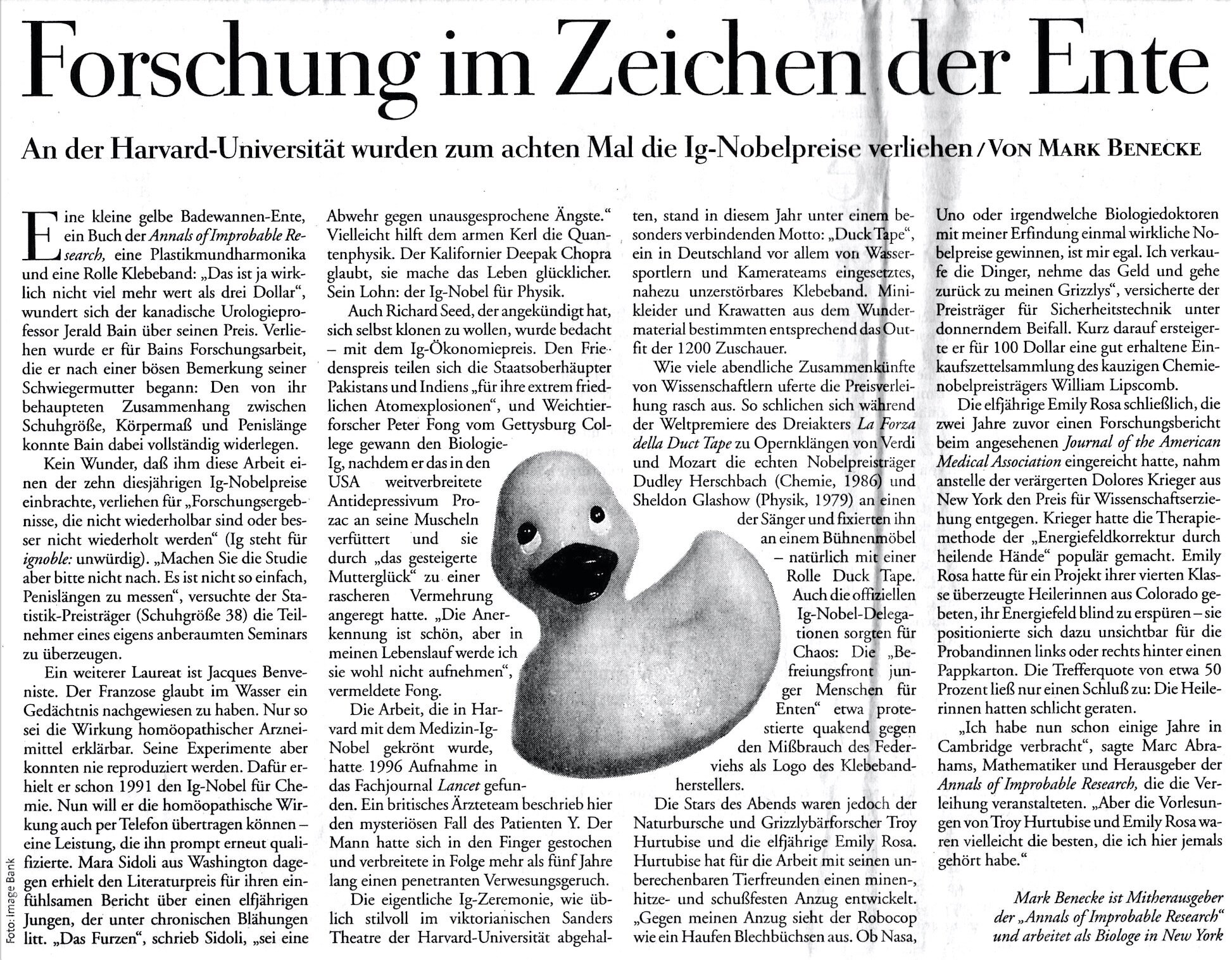2005-10 AIR:Exploading Toads
Source: Annals of Improbable Research, Vol. 11 (Issue Sept/Oct 2005): 18-22, click for .pdf
Exploding Toads...The Storied Remains
A "dream team" of scientists takes on a nightmarish problem
by Mark Benecke, Forensic Biologist, International Forensic Research and Consulting, Cologne, Germany
C. W. Moeliker, Curator of Birds, Natuurmuseum Rotterdam, The Netherlands
Richard Wassersug, Professor, Department of Anatomy and Neurobiology, Dalhousie University, Halifax, Canada
Redacted by Marc Abrahams, Editor, AIR
Earlier this year, news reports described a sudden plague of exploding toads in Hamburg, Germany. The reports carried conflicting descriptions and speculation from scientists, governmental officials, passersby, and other authorities -- some said these were spontaneous explosions, some attributed them to attacks by killer crows, some to bacterial or viral action.
Others advanced still more exotic theories. The public was left with a confused notion as to what exactly had happened, and how and why. To make sense of the reports, we assembled an international "dream team" -- three extraordinarily curious, determined scientists, each of whom has a deep background in one or more elements of the apparent story. Their assignment: to try to discover the truth about the exploding toads of Hamburg.
Mark Benecke is one of the world's leading forensic biologists. Benecke is based in Cologne, Germany.
C.W. ("Kees") Moeliker is one of the world's leading experts on crows and many other birds. Moeliker was awarded the 2002 Ig Nobel Prize in Biology, for publishing the world's first scientifically documented case of homosexual necrophilia in the mallard duck. Moeliker is based at the Natuurmuseum Rotterdam, in The Netherlands.
Richard Wassersug is one of the world's leading authorities on frogs, toads, and many other amphibians. He was awarded the 2000 Ig Nobel Biology Prize for conducting a test of the comparative palatability of some dry-season tadpoles from Costa Rica. Wassersug is based at Dalhousie University, in Halifax, Nova Scotia, Canada.
All are members of the editorial board of the Annals of Improbable Research. Their research was conducted, as much of today's highly publicized research is, hastily and via email. Here is a concise, edited compilation of their collected reports.
From Mark Benecke (European Forensic Entomologist):</font>
Northern American and Dutch people laugh about Germans because we drink Kefir (rotten milk; available in every German supermarket) to prolong the span of life, and use homeopathy (super-diluted substances proven to not have any effect, but available at every German medical doctor) to cure illnesses.
At the same time, most Germans laugh about Northern Americans because of them writing the numbers "1" and "7" without a dash (out of superstition?), putting month before day (i.e., not in a logical order), and also for not knowing where The Netherlands can be found on a map of the world. The "Exploding Toad" Problem was not noted in the German news media until after it had made it big into international newspapers. This alleged miracle united scientists -- three of us, anyway -- from three different regions of the world, in an interesting search for a quite hard-to-find truth. Our different approaches illustrate quite nicely how each of our respective fields of work influences the course of an investigation, and therefore also the results of the quest.
The story grew as if nourished in rich ground -- there exist many legends and even modern references to exploding toads. The original claim, which quickly spread around the world, appeared in news reports in late April, 2005. One version of it said:
Werner Smolnik, environmental movement worker, stated on April 26, 2005 that in the previous four days, at least 1,000 toads in the city of Hamburg, Germany had died by explosion. He is quoted as saying: "It could be an unknown virus, or a fungus that has infected the water, or a defense mechanism against aggressive crows which have appeared in the area recently. ... But we haven't a clue. Soon there will be no toads left!
What differentiates the exploding-toads incidents from most other exploding-animal stories is that these toads reportedly explode while alive. Exploding whales, for example, are a result of the build-up of gases during the process of decomposition (except when the use of dynamite is involved).
From Richard Wassersug (North American Amphibian Specialist)
I can understand that people who are not concerned about disappearing wildlife from our planet might find a mysterious and lethal epidemic in frogs funny. I recognize that for our species, frogs are simply funny whether they are jumping, dying, or just sitting still. However, I am scientifically too close to the core problem to be able see it as a topic that I can explore in a strictly humorous vein.
I am not always this humorless and I can assure you that I would find it immensely funny and worthy of continual follow-up if I knew that animals other than my frogs were finding a new and explosive way of departing the planet.
Sorry I'm such a curmudgeon.
From Mark Benecke (European Forensic Entomologist)
I did my initial research on the toad thing by straightaway calling everybody involved. This technique did work. Here are my preliminary findings.
A) People did actually observe some toads that were "bloated," but the animals were alive! They (the toads) then died. Therefore, most likely, the toads were just fighting for their lives after an attack, and just as a reflex tried to get rid of the offender (or of the observing human beings) by bloating and looking big, fat, and ugly.
B) The very good, city-owned Institute for Hygiene in the city of Hamburg did not find any relevant amounts of chemicals, viruses or bacteria. They found nothing, not even chlamydia, either in the exploded toads or in the little water basin where the toads all died. (I got this information from the person who did the measurements, not from an "official speaker" or other politically motivated person.)
C) On May 8, 2004 a British newspaper (The Independent) reported that Frank Mutschmann, a German toad expert, had examined both dead and living Hamburg specimens at his Berlin research center. Here is a portion of that newspaper report:
[Mutschmann] found all had identical circular incisions on their backs, small enough to be the work of a bird's beak.
There were no bite or scratch marks, so we knew the toads weren't being attacked by a raccoon or rat, which would have also eaten the entire toad," he said. "It was clearly the work of crows, which are clever enough to know the toad's skin is toxic and realise the liver is the only part worth eating. Only once the liver is gone does the toad realise it's been attacked. It puffs itself up as a natural defence mechanism. But since it doesn't have a diaphragm or ribs, without the liver there is nothing to hold the rest of its organs in. The lungs stretch out of all proportion and rip; the rest of the organs simply expel themselves." The toads' grisly deaths are, in fact, a well-documented phenomenon. First recorded in Germany in 1968, exploding toads have been reported in the country, as well as in Belgium, Denmark and America. Hamburg's toads started to explode during their week-long mating season.
D) It is indeed unlikely that 1,300 toads were killed by crows. Some of the news reports said, or strongly implied, that killer crows were to blame, that the crows were plucking the livers from living toads. But no German bird or toad specialist (I called the two most senior ones) ever observed such a high number of toads killed by birds. It remains possible that other animals are the reason. For example, polecats do this sometimes over here. They just rip open the nasty tasting skin to reach the nice and soft liver.
E) No toads died afterwards. The incident, to whatever extent it did or did not occur, was of very limited duration.
F) None of the dead toads are left for a forensic biology treatment in my lab. The exploded animals were stored in the refrigerator of the Institute in Hamburg (instead of in the freezer, argh!) so the smell was unbearable for the lab personnel. Sigh.
From C.W. Moeliker (European Bird Expert)
What you have discovered "cuts wood" (as we say here in Holland). It now becomes (almost) clear what might have caused the dramatic death of the frogs. The funny side of it is the nonsense that has polluted the press-reports. There is indeed no really humorous side of the exploding frogs -- but it sure is 'improbable.' I hope and feel what happened in Germany is just an isolated incident, and that toads, somewhere, will reproduce and reproduce to make up for that terrible loss.
It is as with the birds that get killed in collision with windows (a subject on which I have done some improbable research). Ornithologists in Britain have figured out the numbers of birds that die that way each year. The numbers are unimaginable and beyond comprehension on a global scale. But still, there are birds everywhere.
I do my best to plead the case that, on the charge of causing toads to explode, the birds are not guilty.'
***
Finally, for what it's worth as a form of indirect commentary on this whole thing, here is Wikipedia's entry on the subject of "Exploding Toad Fiction" (July 2005):
In a story titled "The Frog and the Ox" of the Aesop's Fables, a frog, seeing an ox walking by, wanted to become as large and powerful as the ox. The poor frog filled herself full of air again and again. It exploded as a result.
In the film Reflecting Skin, two boys insert a drinking straw into a toad's cloaca and inflate it, leaving it on the side of a path. The first person to come by and see the poor suffering toad bends over to inspect it, only to have it explode all over them when the boys shoot it with a slingshot. A widely-circulated urban legend claims that you can explode a toad by putting a cigarette in its mouth because toads inhale through their mouths but they exhale through their skin. If the air is too polluted this process cannot be completed and the gases continue to build up until they explode.
The experimental music group Coil wrote a song called "Omlagus Garfungiloops" that features a voice sample saying, "Have you been exploding frogs again?" The title of the song is based on taking the above voice sample and playing parts of it backwards to achieve a strange non-language.









